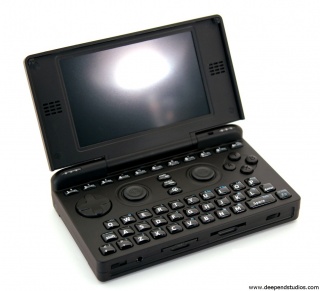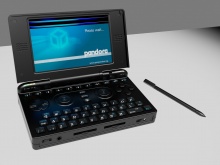Difference between revisions of "Pandora"
m (A couple links didn't go anywhere.) |
(→History) |
||
| Line 4: | Line 4: | ||
==History== | ==History== | ||
| − | On September 30, 2008, 3000 units were made available for pre-order. Later on, the number of units was increased to 4000. The release of the Pandora was delayed several times, until finally, in May 2010 when mass production and shipping of the Pandora began. | + | On September 30, 2008, 3000 units were made available for pre-order. Later on, the number of units was increased to 4000. The release of the Pandora was delayed several times, until finally, in May 2010 when mass production and shipping of the Pandora began. A [[TimeLine]] page describes the process. |
==Availability== | ==Availability== | ||
Revision as of 17:50, 26 June 2010
The Pandora is a combination of a seventh-generation handheld game console and miniature computer. It is the spiritual successor to other open handheld consoles such as the GP32 and GP2X. The device is open, meaning you can use it however you like and there are no restrictions or fees placed on developers, so anyone can write and release software for it. It runs a custom distribution of Linux based on Ångström and is currently the most powerful handheld gaming console available.
Contents
History
On September 30, 2008, 3000 units were made available for pre-order. Later on, the number of units was increased to 4000. The release of the Pandora was delayed several times, until finally, in May 2010 when mass production and shipping of the Pandora began. A TimeLine page describes the process.
Availability
For the first batch, 4000 units were made available to be pre-ordered for $330 USD each. Currently (as of June 2010) these are being assembled and shipped out to customers. However, there is a possibility that a spot will become available to anyone wanting to pre-order as some pre-orderers choose to cancel before receiving their unit.
It is expected that a second batch will be available for pre-order before all of the first 4000 batch have shipped. The price will increase to at least $349 USD [1].
Capabilities
The Pandora is a very unique device. Currently, there is no other device available which has dedicated gaming controls (including two analog nubs) and an almost full QWERTY keyboard. It's primary use is as a game console, specifically, a device to emulate older systems (see Emulator List). There are also games which are made for it as well (see Games List). It's secondary use is as a handheld computer. You can use it to do many of the tasks you would any other computer, such as browsing the Internet (with a full web browser), listening to music, watching movies and shows, using instant messaging applications, etc.
There are also a few things it can't do. Specifically, it can't run software which is only available in Windows, though if the source code is available there is a possibility it could be ported to run on the Pandora. Also, closed source Linux applications won't run without a port (as they were made to run on the x86 architecture while the Pandora is ARM).
Specifications
Core Hardware
- Texas Instrument's OMAP3530 System-on-chip. [2] [3] Specifications can be found at this link: [4]
- PowerVR SGX GPU (OpenGL ES 2.0, several million polygons per second). OpenGL ES demonstrated: [5]
- 256MB of DDR SDRAM in consumer units (early developer units had 128MB).
- Real Time Clock (RTC) built in, to keep track of time. [6]
- 512MB of internal flash memory (NAND) for consumer Pandoras (early developer boards has 256MB).
- Is "unbrickable", through a ROM bootloader.
- Dimensions: 140 x 83 x 27 mm (See Size Comparisons)
- Mass: 320g [7] (0.739 lbs)
Display
- 800x480 widescreen (5:3), 4.3 inches, touchscreen LCD.[8]
- Brightness:300 cd/m2, Contrast ratio:450:1, Response time:tr+tf=30ms[9]
- Dimensions: 93.6 x 56.2 mm (4.3 inches, 5:3 aspect ratio).
- TV-out included in hardware, A/V-OUT Port (similar in appearance to a large USB OTG port) outputs S-Video and Composite and inputs 3,5mm Headphone/Microphone cables..
- Separate TV-out signals, picture-in-picture capabilities. [10]
- Powerful 2D and 3D hardware acceleration, see above. [11]
Sound
- Has a high-quality sound DAC, and an ADC.
- A pair of stereo speakers are built into the display.
- The volume control is a wheel.
- Built-In Microphone [12]
Input
- Buttons, keyboard, microphone, and touchscreen. [13]
- Directional pad will be a D-pad. [14]
- Two real, custom designed, plastic analog nubs.
- QWERTY keyboard (cellphone like, but larger). [15]
Connectivity
- 802.11b/g (Wi-fi) included. USB host included. USB-on-the-go (one-port host and client) included. [16]
- Integrated Bluetooth 2.0 + EDR (3Mbps)[17]
- USB OTG mini-AB port and fully powered (500 mA) standard-A port. You can use anything that has the appropriate drivers. [18] Some devices need to first go through a powered USB hub.
- RS-232 included, but a level converter is needed for the UART. [19]
- Twin SDIO-capable SDHC slots.
Power
- Lithium-polymer battery, ~4000mAH.
- Up to 10 hours battery life under reasonable load, 8.5 hours under max CPU load. Up to 100 hours playing MP3s. [20]
- Can charge through an AC adapter or USB. [21]
- Advanced power management capabilities: only need to set a max clockspeed, when the CPU is not doing anything it automatically HALTs and does nothing to save power.[22]
- Will be able to suspend to RAM or suspend to disk for longer battery life and faster start up.

